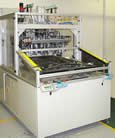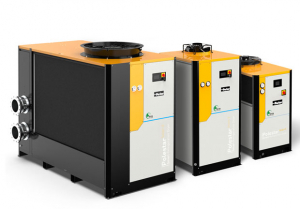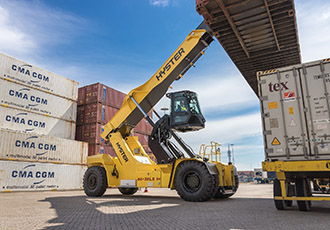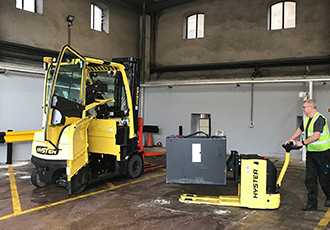ATM Automation Offers Multiple Plastic Joining Technologies
22nd May 2008
Source:
ATM Automation Limited

ATM has, for many years, been recognised as the leading supplier of Robotics and Automation to the plastics industry within the United Kingdom. This reputation has been built upon ATM’s ability to provide a diverse range of technologies and solutions for applications such as de-moulding, parts handling and assembly. With component manufacturer’s now increasingly adding value to their product by performing more of the downstream assembly operations, plastic joining has become a key growth area for ATM.
In house plastics joining development lab
With a history of almost 40 years within the UK Automation industry, ATM has seen many changes, not only in the technologies used in the marketplace but also in the demands of manufacturers and end users. Many companies now insist on a “Turnkey” approach to their specific application and this brings with it a need for the automation supplier to become much more conversant with a broader range of technologies and processes. This is especially so in the field of plastics joining where it is essential that the correct process is selected based upon the individual application and the materials to be joined.
To ensure the most appropriate process is proposed for any given application, ATM has recently opened its in-house plastics joining laboratory. This new resource, backed by the extensive experience of ATM’s plastic joining specialist – John Neugebauer, enables customer applications to be evaluated ahead of the proposal stage thus determining not only the best process for the application, but also enabling cycle times and process parameters to be defined in advance.
The ATM in-house laboratory has a number of different technologies available for evaluation including:-
• Pulse Staking
• Hot Air-Cold Staking
• Ultrasonic
Each of the different technologies can be tried and tested on the customer’s sample parts to determine the process best suited to the materials under evaluation. In some cases, there will be perhaps two or more technologies which can successfully join the parts. In these instances, depending upon the number of stake points or weld positions, cycle time required and aesthetic appearance required, one technology may then be deemed more appropriate for that specific application.
The plastics joining knowledge resident within ATM, together with the range of technologies available for evaluation, provides the customer with an un-biased view of the different technologies, their characteristics and their likely benefits or indeed drawbacks.
Hot Air-Cold Staking is a traditional joining method which has been used for many years in a multitude of applications. Seen as a simple technology which can be used easily by un-skilled operators, this process is also relatively inexpensive especially where the components have multiple stake positions. The disadvantages of this process however include the fact that for a small number of stake points or tips the process is not particularly energy efficient. The process is not suited to hand held operation and also in some applications, the gap between the hot air nozzle and the stake point is critical if consistent quality is to be achieved. This renders the process less suitable for applications where the component tolerances may not be sufficiently tight. Additionally any concentration of heat energy applied to a confined area containing several stakes may stress relieve a moulded component causing unacceptable distortion.
Ultrasonic welding systems are used extensively for many applications, but as for other joining processes, this too has limitations. When applied to materials with a high glass or mineral fill content (40% to 50%) the ultrasonic process can cause particle fragmentation which is unacceptable in certain safety critical applications found in the production of Aerospace or Military components and automotive seat restraint and air bag applications. The use of ultrasonic welding on electro-mechanical components and PCB’s can also pose a problem due to the high frequency vibrations generated, as can the use of the technology in close proximity of metal components. Consideration must also be given to the noise generated by the process, and appropriate steps must be taken to prevent prolonged operator exposure to the high frequency sound.
Ultrasonic welding does however have a number of advantages. It is possible to have a hand held unit which enables the use of the technology on low volume production or where a dedicated multi-tip machine cannot be justified. The process is also quick and can generally be used on a wide range of materials. Where multi tip applications are required, a number of sonotrodes can be operated from a single generator unit by switching from one tip to another in a pre-defined sequence, thus helping to reduce the overall cost of the machine.
A less well known process, pioneered in the United Kingdom by ATM, is the patented “Pulse-Staking” technology. Available as a portable hand held device or integrated into multi head desk top or floor standing machines, Pulse-Staking works by accurately controlling the amount of time a current passes through a specially designed tip which is rapidly heated to the melt temperature of the material being processed. The current is “pulsed” on and off to ensure that the material does not overheat and begin to degrade. At the end of the “pulsed” heating cycles, compressed air is passed through a central tube which rapidly cools the tip and allowing the plastic to solidify rapidly. The small heat affected zone around the Pulse-Staking tip, plus the fact that the process does not generate any vibrations, makes Pulse-Staking ideal for applications on electronic components and PCB’s. The process is also unaffected by the close proximity of metal components and the controlled nature of the heating cycle also makes it more suitable for materials which have a high filler content.
Hybrid machine
Selecting the most appropriate process for an individual application can mean that on occasions two different technologies will be used together within a “Hybrid” machine. One such example was a rotary table welding machine designed and built by ATM for the production of powder print cartridges. This machine employed ultrasonic technology to weld a plastic cap onto one end of the cartridge housing whilst a multiple tip Pulse-Stake head staked an ID tag in the form of a small PCB at the other end of the assembly. With a very localised heat affected zone and with no vibrations generated from the process, Pulse-Staking was deemed to be the most appropriate technology for this part of the assembly process. This “Hybrid” machine operates very successfully and is an excellent example of the unbiased approach adopted by ATM for every individual application.
With a history of almost 40 years within the UK Automation industry, ATM has seen many changes, not only in the technologies used in the marketplace but also in the demands of manufacturers and end users. Many companies now insist on a “Turnkey” approach to their specific application and this brings with it a need for the automation supplier to become much more conversant with a broader range of technologies and processes. This is especially so in the field of plastics joining where it is essential that the correct process is selected based upon the individual application and the materials to be joined.
To ensure the most appropriate process is proposed for any given application, ATM has recently opened its in-house plastics joining laboratory. This new resource, backed by the extensive experience of ATM’s plastic joining specialist – John Neugebauer, enables customer applications to be evaluated ahead of the proposal stage thus determining not only the best process for the application, but also enabling cycle times and process parameters to be defined in advance.
The ATM in-house laboratory has a number of different technologies available for evaluation including:-
• Pulse Staking
• Hot Air-Cold Staking
• Ultrasonic
Each of the different technologies can be tried and tested on the customer’s sample parts to determine the process best suited to the materials under evaluation. In some cases, there will be perhaps two or more technologies which can successfully join the parts. In these instances, depending upon the number of stake points or weld positions, cycle time required and aesthetic appearance required, one technology may then be deemed more appropriate for that specific application.
The plastics joining knowledge resident within ATM, together with the range of technologies available for evaluation, provides the customer with an un-biased view of the different technologies, their characteristics and their likely benefits or indeed drawbacks.
Hot Air-Cold Staking is a traditional joining method which has been used for many years in a multitude of applications. Seen as a simple technology which can be used easily by un-skilled operators, this process is also relatively inexpensive especially where the components have multiple stake positions. The disadvantages of this process however include the fact that for a small number of stake points or tips the process is not particularly energy efficient. The process is not suited to hand held operation and also in some applications, the gap between the hot air nozzle and the stake point is critical if consistent quality is to be achieved. This renders the process less suitable for applications where the component tolerances may not be sufficiently tight. Additionally any concentration of heat energy applied to a confined area containing several stakes may stress relieve a moulded component causing unacceptable distortion.
Ultrasonic welding systems are used extensively for many applications, but as for other joining processes, this too has limitations. When applied to materials with a high glass or mineral fill content (40% to 50%) the ultrasonic process can cause particle fragmentation which is unacceptable in certain safety critical applications found in the production of Aerospace or Military components and automotive seat restraint and air bag applications. The use of ultrasonic welding on electro-mechanical components and PCB’s can also pose a problem due to the high frequency vibrations generated, as can the use of the technology in close proximity of metal components. Consideration must also be given to the noise generated by the process, and appropriate steps must be taken to prevent prolonged operator exposure to the high frequency sound.
Ultrasonic welding does however have a number of advantages. It is possible to have a hand held unit which enables the use of the technology on low volume production or where a dedicated multi-tip machine cannot be justified. The process is also quick and can generally be used on a wide range of materials. Where multi tip applications are required, a number of sonotrodes can be operated from a single generator unit by switching from one tip to another in a pre-defined sequence, thus helping to reduce the overall cost of the machine.
A less well known process, pioneered in the United Kingdom by ATM, is the patented “Pulse-Staking” technology. Available as a portable hand held device or integrated into multi head desk top or floor standing machines, Pulse-Staking works by accurately controlling the amount of time a current passes through a specially designed tip which is rapidly heated to the melt temperature of the material being processed. The current is “pulsed” on and off to ensure that the material does not overheat and begin to degrade. At the end of the “pulsed” heating cycles, compressed air is passed through a central tube which rapidly cools the tip and allowing the plastic to solidify rapidly. The small heat affected zone around the Pulse-Staking tip, plus the fact that the process does not generate any vibrations, makes Pulse-Staking ideal for applications on electronic components and PCB’s. The process is also unaffected by the close proximity of metal components and the controlled nature of the heating cycle also makes it more suitable for materials which have a high filler content.
Hybrid machine
Selecting the most appropriate process for an individual application can mean that on occasions two different technologies will be used together within a “Hybrid” machine. One such example was a rotary table welding machine designed and built by ATM for the production of powder print cartridges. This machine employed ultrasonic technology to weld a plastic cap onto one end of the cartridge housing whilst a multiple tip Pulse-Stake head staked an ID tag in the form of a small PCB at the other end of the assembly. With a very localised heat affected zone and with no vibrations generated from the process, Pulse-Staking was deemed to be the most appropriate technology for this part of the assembly process. This “Hybrid” machine operates very successfully and is an excellent example of the unbiased approach adopted by ATM for every individual application.
Similar articles
More from ATM Automation Limited
- ATM Automation & ILPRA Combine Experience for PPMA 2009 18th August 2009
- ATM Automation & ILPRA Package Their Skills 11th August 2009
- ATM Cartesian Robots – Still a Major Player in Plastics 6th February 2009
- Preventative Maintenance, Training and Spare Parts Improve Productivity and Profits 14th November 2008




.jpg)







Write a comment
No comments